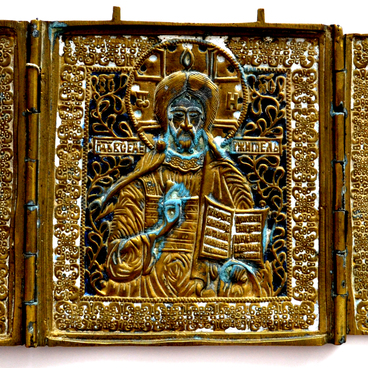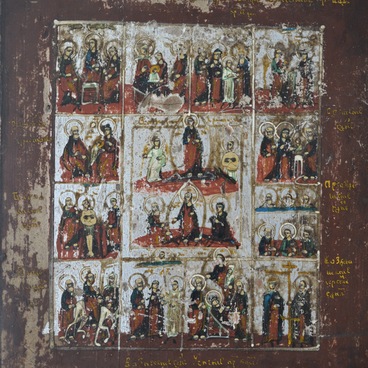The image of Virgin Mary is one of the most beloved ones and one of the most common ones in icon painting. Icons of the type Joy of All Who Sorrow first appeared in the XVII century. The development of this type of icon was influenced by Western European art where the Virgin’s Immaculate Conception was often painted. The paintings conveyed a festive atmosphere, the triumph of faith and the glory of the Holy Virgin.
The Joy of All Who Sorrow
Creation period
ΧIΧ century
Dimensions
32x25 cm
32х25х3 cm
32х25х3 cm
Technique
Painting, tempera and gilding on wood
Collection
Exhibition
2
Open in app#1
Unknown Author
The Joy of All Who Sorrow
#3
#2
In the center of the icon, we can see Virgin Mary surrounded by clouds and with baby Jesus in her arms. They emanate divine light. The Holy Virgin is surrounded by people suffering from all kinds of diseases and misfortunes that are asking her for healing and rescue.
Over Virgin Mary, we can see Sabaoth: that was the name of God the Father in the Holy Writ. On the left and on the right, there are the Sun and the Moon, the celestial bodies from the heavenly host that symbolize the Universe.
#5
Virgin Mary and Jesus Christ have crowns on their heads. That was how icon painters conveyed their regality and the triumph of the righteous over the sinners. The angels on each side of Our Lady are doing good deeds and healing the praying people.
#7
The original of the icon Joy of All Who Sorrow was said to have healing power. According to the legend, in 1688, Moscow Patriarch’s sister Eufemia Papina was suffering from a severe non-healing wound. After losing hope for healing, she asked Our Lady for help. The Holy Virgin appeared to Eufemia and ordered her to pray in front of the icon in the Transfiguration church in the Ordynka Street in Moscow. The wound healed right after the prayer.
This icon has many variations. Oftentimes, saints were painted over the rows of the suffering people, and at the top, beside Sabaoth, the New Testament Holy Trinity was depicted. In early icons of this type, painted in the XVII century, there were no suffering people at all: artists started to paint them only after Eufemia’s miraculous healing.
On the day of her healing, 6th of November according to the Gregorian calendar, the Moscow Patriarch established a holiday in commemoration of the Holy Virgin. The Orthodox people believed that the icon could heal anyone who prayed to it, and artisans in the whole Russia started making and distributing its copies.
This copy of the icon of Our Lady the Joy of All Who Sorrow was made by an unknown artist in the XIX century. It is a painting with a gilded frame.
This icon has many variations. Oftentimes, saints were painted over the rows of the suffering people, and at the top, beside Sabaoth, the New Testament Holy Trinity was depicted. In early icons of this type, painted in the XVII century, there were no suffering people at all: artists started to paint them only after Eufemia’s miraculous healing.
On the day of her healing, 6th of November according to the Gregorian calendar, the Moscow Patriarch established a holiday in commemoration of the Holy Virgin. The Orthodox people believed that the icon could heal anyone who prayed to it, and artisans in the whole Russia started making and distributing its copies.
This copy of the icon of Our Lady the Joy of All Who Sorrow was made by an unknown artist in the XIX century. It is a painting with a gilded frame.
#8
Iskitim Municipal Museum of Arts and History
read morehide
00:00
00:00
1x
The Joy of All Who Sorrow
Creation period
ΧIΧ century
Dimensions
32x25 cm
32х25х3 cm
32х25х3 cm
Technique
Painting, tempera and gilding on wood
Collection
Exhibition
2
Open in app
Share

